 W
WA cannon is a large-caliber gun classified as a type of artillery, and usually launches a projectile using explosive chemical propellant. In the past, black gunpowder was the primary propellant before the invention of smokeless powder during the late 19th century. Cannon vary in gauge, effective range, mobility, rate of fire, angle of fire and firepower; different forms of cannon combine and balance these attributes in varying degrees, depending on their intended use on the battlefield. The word cannon is derived from several languages, in which the original definition can usually be translated as tube, cane, or reed. In the modern era, the term cannon has fallen into decline, replaced by guns or artillery if not a more specific term such as howitzer or mortar, except for high-caliber automatic weapons firing bigger rounds than machine guns, called autocannons. The word "cannon" can be both singular and plural.
 W
WThe 32-pounder guns were sets of heavy-caliber pieces of artillery mounted on warships in the last century of the Age of sail.
 W
WAn anti-tank gun is a form of artillery designed to destroy tanks and other armored fighting vehicles, normally from a static defensive position. The development of specialized anti-tank munitions and anti-tank guns was prompted by the appearance of tanks during World War I. To destroy hostile tanks, artillerymen often used field guns depressed to fire directly at their targets. However, this practice expended too much valuable ammunition and was of increasingly limited effectiveness as tank armor became thicker. The first dedicated anti-tank artillery began appearing in the 1920s and by World War II was a common appearance in many European armies. In order to penetrate armor they fired specialized ammunition from longer barrels to achieve a higher muzzle velocity than field guns. Most anti-tank guns were developed in the 1930s as improvements in tanks were noted, and nearly every major arms manufacturer produced one type or another.
 W
WThe Architonnerre (Architronito) was a steam-powered cannon, a description of which is found in the papers of Leonardo da Vinci dating to the late 15th century, although he attributes its invention to Archimedes in the 3rd century BC.
 W
WBacchawali Tope is a gun, rather cannon which lies in the Nizamat Fort Campus on the garden space between the Nizamat Imambara and the Hazarduari Palace and to the east of the old Madina Mosque in the city of Murshidabad in the Indian state of West Bengal. The cannon consists two pieces of different diameters. The cannon was made between the 12th and 14th century, probably by the Mohammeddan rulers of Gaur. It originally lied on the sand banks of Ichaganj. However, it is unknown that how it came in Ichaganj. It was used to protect the city of Murshidabad from north-western attacks. After the 1846 fire of the Nizamat Imambara the Imambara was rebuilt, then after the completion of the new Imambara the cannon was shifted to its present site by Sadeq Ali Khan, the architect of the sacred Nizamat Imambara under the suggestion of Sir Henry Torrens, the then agent of the Governor General at Murshidabad.
 W
WThe basilisk was a very heavy bronze cannon employed during the Late Middle Ages. The barrel of a basilisk could weigh up to 4,000 lb (1,800 kg) and could have a calibre of up to 5 inches (13 cm). On average they were around 10 feet long, though some, like Queen Elizabeth's Pocket Pistol, were almost three times that length.
 W
WBedil is a term from Nusantara area of Maritime Southeast Asia which refers to various type of firearms and gunpowder weapon, from small matchlock pistol to large siege guns. The term bedil comes from wedil and wediluppu in Tamil language. In its original form, these words refer to gunpowder blast and saltpeter, respectively. But after being absorbed into bedil in Malay language, and in a number of other cultures in the archipelago, that Tamil vocabulary is used to refer to all types of weapons that use gunpowder. In Javanese and Balinese the term bedil and bedhil is known, in Sundanese the term is bedil, in Batak it is known as bodil, in Makasarese, badili, in Buginese, balili, in Dayak language, badil, in Tagalog, baril, in Bisayan, bádil, in Bikol languages, badil, and Malay people call it badel or bedil.
 W
WBedil tombak or bedil tumbak is a type of early firearm from the Nusantara archipelago. The weapon consist of a gun or small cannon mounted on a wooden pole, forming a type of weapon known as "pole gun".
 W
WAlbert Benningk (1637-1695) was a German bellfounder and producer of baroque cannons. He was mainly active at the municipal foundry of the Hanseatic city of Lübeck and in his later life in Copenhagen.
 W
WThe Brooke rifle was a type of rifled, muzzle-loading naval and coast defense gun designed by John Mercer Brooke, an officer in the Confederate States Navy. They were produced by plants in Richmond, Virginia, and Selma, Alabama, between 1861 and 1865 during the American Civil War. They served afloat on Confederate ships and ashore in coast defense batteries manned by the Confederate States Army.
 W
WCalcutts Ironworks was an ironworks in Jackfield, in Shropshire, England. It was established in 1767, and production ceased in 1828. The works became an important producer of cannon.
 W
WA carronade is a short, smoothbore, cast-iron cannon which was used by the Royal Navy. It was first produced by the Carron Company, an ironworks in Falkirk, Scotland, and was used from the 1770s to the 1850s. Its main function was to serve as a powerful, short-range, anti-ship and anti-crew weapon. The technology behind the carronade was greater dimensional precision, with the shot fitting more closely in the barrel thus transmitting more of the propellant charge's energy to the projectile, allowing a lighter gun using less gunpowder to be effective. Carronades were initially found to be very successful, but they eventually disappeared as naval artillery advanced, with the introduction of rifling and consequent change in the shape of the projectile, exploding shells replacing solid shot, and naval engagements being fought at longer ranges.
 W
WA cascabel is a subassembly of a muzzle-loading cannon, a knob to which to attach arresting ropes to deal with the recoil of firing the cannon.
 W
WThe Cetbang was a type of cannon produced and used by the Majapahit Empire (1293–1527) and other kingdoms in the Indonesian archipelago. The cetbang is a breech-loading cannon, it is different from typical European and Middle Eastern cannons, which are usually muzzleloader. In the Sekar inscription it states that the main production foundries of cetbang were in Rajekwesi, Bojonegoro, whereas the black powder was produced in Swatantra Biluluk (Lamongan).
 W
WThe Chongtong was the term for Joseon-era gunnery. There were many different types, various improvements over the years, often including renaming. The well-known "Cheonja", "Jija", "Hyeonja", and "Hwangja" were named after the first four characters of the Thousand Character Classic in decreasing size, thus making them equivalent to Cannons A, B, C, and D.
 W
WThe columbiad was a large-caliber, smoothbore, muzzle-loading cannon able to fire heavy projectiles at both high and low trajectories. This feature enabled the columbiad to fire solid shot or shell to long ranges, making it an excellent seacoast defense weapon for its day. Invented by Colonel George Bomford, United States Army, in 1811, columbiads were used in United States seacoast defense from the War of 1812 until the early years of the 20th century. Very few columbiads were used outside of the U.S. and Confederate Armies; nevertheless, the columbiad is considered by some as the inspiration for the later shell-only cannons developed by Frenchman Henri-Joseph Paixhans some 30 years later.
 W
WA culverin was a relatively simple ancestor of the musket, and later a medieval cannon, adapted for use by the French as the "couleuvrine" in the 15th century, and later adapted for naval use by the English in the late 16th century. The culverin was used to bombard targets from a distance. The weapon had a relatively long barrel and a light construction. The culverin fired solid round shot projectiles with a high muzzle velocity, producing a relatively long range and flat trajectory. Round shot refers to the classic solid spherical cannonball.
 W
WThe demi-cannon was a medium-sized cannon, similar to but slightly larger than a culverin and smaller than a regular 42 lb (19 kg) cannon, developed in the early seventeenth century. A full cannon fired a 42-pound shot, but these were discontinued in the eighteenth century as they were seen as too unwieldy. The lower tiers of seventeenth century English warships were usually equipped with demi-cannons.
 W
WThe demi-culverin was a medium cannon similar to but slightly larger than a saker and smaller than a regular culverin developed in the late 16th century. Barrels of demi-culverins were typically about 11 feet (3.4 m) long, had a calibre of 4 inches (10 cm) and could weigh up to 3,400 pounds (1,500 kg). It required 6 pounds (2.7 kg) of black powder to fire an 8-pound (3.6 kg) round shot. The demi-culverin had an effective range of 1,800 feet (550 m).
 W
WThe first usage of cannon in Great Britain was possibly in 1327, when they were used in battle by the English against the Scots. Under the Tudors, the first forts featuring cannon batteries were built, while cannon were first used by the Tudor navy. Cannon were later used during the English Civil War for both siegework and extensively on the battlefield.
 W
WThe falconet was a light cannon developed in the late 15th century that fired a smaller shot than the similar falcon. During the Middle Ages guns were decorated with engravings of animals, such as reptiles, birds or mythical beasts depending on their size. For example, a culverin would often feature snakes, as the handles on the early cannons were often decorated to resemble serpents. The falconet fired small yet lethal shot of similar weight and size to a bird of prey, and so was decorated with a falcon. Similarly, the musket was associated with the sparrowhawk.
 W
WA field gun is a field artillery piece. Originally the term referred to smaller guns that could accompany a field army on the march, that when in combat could be moved about the battlefield in response to changing circumstances, as opposed to guns installed in a fort, or to siege cannons and mortars which are too large to be moved quickly, and would be used only in a prolonged siege.
 W
WArtillery in the Middle Ages primarily consisted of the introduction of the cannon, large tubular firearms designed to fire a heavy projectile over a long distance. Guns, bombs, rockets and cannons were first invented in China during the Han Chinese Song Dynasty and then later spread to Europe and the Middle East during the period.
 W
WGunpowder weapons in the Song dynasty included the "multiple bullets magazine erupters", consisting of a tube of bronze or cast iron that was filled with about 100 lead balls, and the "flying-cloud thunderclap eruptor", an early cast iron proto-cannon. The use of proto-cannon, and other gunpowder weapons, enabled the Song dynasty to ward off its militant enemies—the Liao, Western Xia, and Jin—until its final collapse under the onslaught of the Mongol forces of Kublai Khan in the late 13th century.
 W
WThe hand cannon, also known as the gonne or handgonne, is the first true firearm and the successor of the fire lance. It is the oldest type of small arms as well as the most mechanically simplistic form of metal barrel firearms. Unlike matchlock firearms it requires direct manual external ignition through a touch hole without any form of firing mechanism. It may also be considered a forerunner of the handgun. The hand cannon was widely used in China from the 13th century onward and later throughout Eurasia in the 14th century. In 15th century Europe, the hand cannon evolved to become the matchlock arquebus, which became the first firearm to have a trigger.
 W
WA harpoon cannon is a whaling implement developed in the late 19th century and most used in the 20th century. It would be mounted on the bow of a whale catcher, where it could be easily aimed with a wide field of view at the target. Powered by black powder and later, smokeless powder, it would generally fire a large steel harpoon, either solid steel or fitted with an exploding black powder, or later, penthrite (PETN) grenade.
 W
WThe history of cannon spans several hundred years from the 12th century to modern times. The cannon first appeared in China sometime during the 12th and 13th centuries. It likely developed in parallel or as an evolution of an earlier gunpowder weapon called the fire lance. The result was a metal projectile firing weapon that replaced other traditional missile weapons such as the bow and arrow, crossbow, and trebuchet. Cannons were used for warfare by the late 13th century in the Yuan dynasty and spread throughout Eurasia in the 14th century. During the Middle Ages, large and small cannons were developed for siege and field battles. After the Middle Ages, most large cannon were abandoned in favor of greater numbers of lighter, more maneuverable field artillery. New defensive fortifications such as bastions and star forts were designed specifically to better withstand artillery sieges. Cannons transformed naval warfare with its deadly firepower, allowing vessels to destroy each other from long range. As rifling became more commonplace, the accuracy of cannon was significantly improved, and they became deadlier than ever, especially to infantry. In World War I, a considerable majority of all deaths were caused by cannon; they were also used widely in World War II. Most modern cannon are similar to those used in the Second World War, including autocannon—with the exception of naval guns, which are now significantly smaller in caliber.
 W
WHongyipao was the Chinese name for European-style muzzle-loading culverins introduced to China and Korea from the Portuguese colony of Macau and by the Hendrick Hamel expedition to Joseon in the early 17th century.
 W
WHu dun pao (虎蹲砲) is the name of two different missile weapons in Chinese history. In the Song dynasty (960–1279), it was a trebuchet and its name is translated into English as Crouching Tiger Trebuchet; in the Ming dynasty (1368–1644), the name was given to a type of bombard and it is known in English as Crouching Tiger Cannon.
 W
WKi Amuk is an ancient cannon belonging to the Sultanate of Banten, which is currently located in front of the Grand Mosque of Banten, Banten Province, Indonesia. Ki Amuk cannon was used to protect the Karanghantu Port in Banten Bay.
 W
WCannon appeared in Korea by the mid 14th century during the Goryeo dynasty and quickly proliferated as naval and fortress-defense weapons. Major developments occurred throughout the 15th century, including the introduction of large siege mortars as well as major improvements that drastically increased range, power, and accuracy.
 W
WLa Consulaire is the name of a very large Algerian Barbary artillery piece which famously defended Algiers harbour. It was looted by the French during the Invasion of Algiers in 1830, on 5 July, and taken as a trophy to Brest, where it is still displayed.
 W
WLantaka or rentaka was a type of bronze portable cannon or swivel gun, sometimes mounted on merchant vessels and warships in Maritime Southeast Asia. It was commonly equipped by native seafaring vessels from the Philippines, Indonesia, Brunei, and Malaysia. Rentaka and lela is known by the Malays as meriam kecil, the difference is that rentaka is smaller in length and bore than a lela.
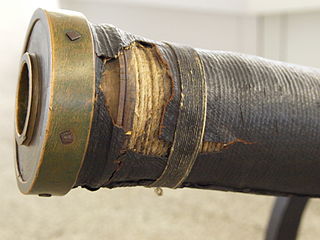 W
WThe leather cannon, or leather gun, was an experimental weapon, first used in northern Europe in the 1620s. The aim was to construct a light and cheap weapon that would bridge the gap between the hand-held musket and the heavy stationary cannon. The varnished leather from which the gun got its name acted merely as the outer protective surface of the piece.
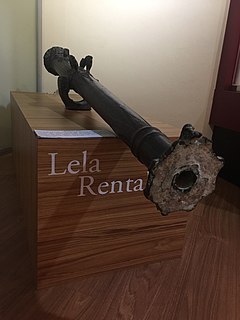 W
WLela or lila is a type of Malay cannon, used widely in the Nusantara archipelago. They are similar to a lantaka but longer and had larger bore. Lela can be configured as swivel gun, fixed gun, or mounted in a gun carriage. It is the equivalent of European falcon and falconet.
 W
WMiniature meriam kecil is a type of very small cannon found on the Indonesian archipelago. Usually the length of these cannons is between 10 to 60 cm, with a caliber of 15 or 16 mm, and has been around for hundreds of years. They are designed and decorated like a normal sized meriam kecil.
 W
WThe minion was a type of small cannon used during the Tudor period and into the late 17th century. It was of a small bore, typically 3-inch (76.2mm), and fired a 5-pound cannonball.
 W
WThe pot-de-fer was a primitive cannon made of iron. It is known as the first metal cannon, and was used by the French in the Hundred Years' War. The name means "iron pot" in French. In Italy, pots-de-fer were known as vasi or vasii, meaning "pot" or "vase".
 W
WThe prangi, paranki, piranki, pirangi, farangi, firingi, or firingiha was a type of cannon produced by Ottoman Empire. It was subsequently copied and produced in other place such as by Mughal empire under Babur. Prangi was a breech-loading swivel gun.
 W
WA cannon is any large tubular firearm designed to fire a heavy projectile over a long distance. They were first used in Europe and China, and were the archetypical form of artillery. Round shot and grapeshot were the early projectiles used in cannon.
 W
WThe Ras Cannons were the first cannons built in South Africa. The two cannons were constructed during the First Boer War on a farm Bokfontein in Brits district.
 W
WRoaring Meg was the name of several powerful cannons used in the 17th century. It is not to be confused with Mons Meg, a medieval bombard preserved at Edinburgh Castle.
 W
WThe Rodman gun is any of a series of American Civil War–era columbiads designed by Union artilleryman Thomas Jackson Rodman (1815–1871). The guns were designed to fire both shot and shell. These heavy guns were intended to be mounted in seacoast fortifications. They were built in 8-inch, 10-inch, 13-inch, 15-inch, and 20-inch bore. Other than size, the guns were all nearly identical in design, with a curving bottle shape, large flat cascabels with ratchets or sockets for the elevating mechanism. Rodman guns were true guns that did not have a howitzer-like powder chamber, as did many earlier columbiads. Rodman guns differed from all previous artillery because they were hollow cast, a new technology that Rodman developed that resulted in cast-iron guns that were much stronger than their predecessors.
 W
WThe saker was a medium cannon, slightly smaller than a culverin, developed during the early 16th century and often used by the English. It was named after the saker falcon, a large falconry bird native to the Middle East.
 W
WThe 95 mm howitzer M1753, called secret howitzer or Shuvalov's secret howitzer, was an 18th-century Russian cannon, a type of muzzle-loading howitzer, devised and introduced into service by artillery commander, General Peter Ivanovich Shuvalov.
 W
WSi Jagur or Ki Jagur is an old cannon of Portuguese heritage which is located in the Jakarta Fatahillah Museum.
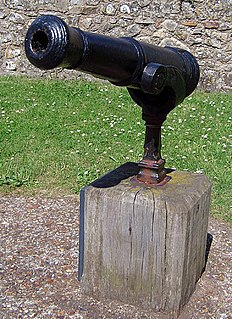 W
WThe term swivel gun usually refers to a small cannon, mounted on a swiveling stand or fork which allows a very wide arc of movement. Another type of firearm referred to as a swivel gun was an early flintlock combination gun with two barrels that rotated along their axes to allow the shooter to switch between rifled and smoothbore barrels.
 W
WThe twelve-pound cannon is a cannon that fires twelve-pound projectiles from its barrel, as well as grapeshot, chain shot, shrapnel, and later shells and canister shot. It was first used during the Tudor period and was commonly used during the Napoleonic Wars, 1799–1815. At this time 12-pounders were the largest caliber of long-barreled field pieces, and were used both at long range against fortifications and troop concentrations using round shot and against attacking infantry and cavalry using canister shot. As such the 12-pounder was a favorite weapon of the Grande Armée. Later, redesigned 12-pounders were named after Napoleon III and found heavy use during the American Civil War.
 W
WA worm is a device used to remove unspent powder bag remnants from a cannon or other piece of muzzle-loading field artillery. It usually took the form of a double corkscrew-shaped piece of iron on the end of a long pole that could be twisted down the barrel to pick up any debris left over from the previous firing of the weapon. It was usually turned twice before being pulled out.
 W
WZamburak, literally meaning wasp, was a specialized form of self-propelled artillery from the early modern period, featuring small swivel guns mounted on and fire from camels. The operator of a zamburak is known as a zamburakchi. The weapon was used by the gunpowder empires, especially the Iranian empires of the Safavid dynasty, Timurid Empire and Afsharid dynasty, due to the ruggedness of the Iranian Plateau, which made typical transportation of heavy cannons problematic.
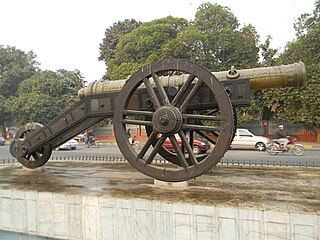 W
WThe Zamzama Gun, also known as Kim’s Gun or Bhangianwali Toap is a large bore cannon. It was cast in about 1757 in Lahore, now in Pakistan but at the time part of the Durrani Empire. It is currently on display in front of the Lahore Museum in Lahore, Pakistan.